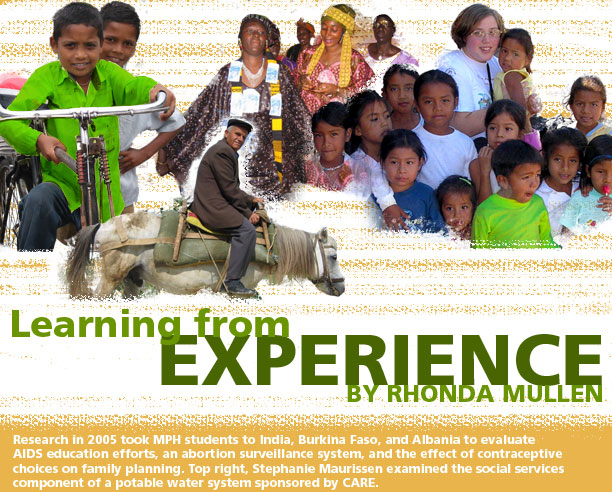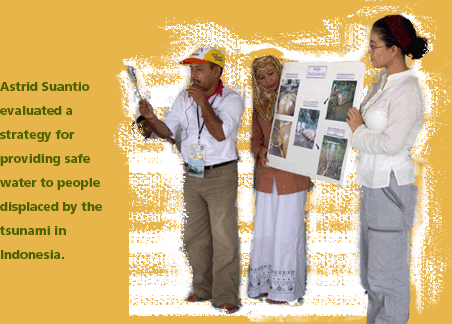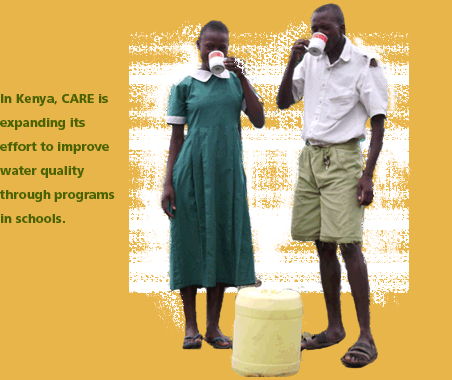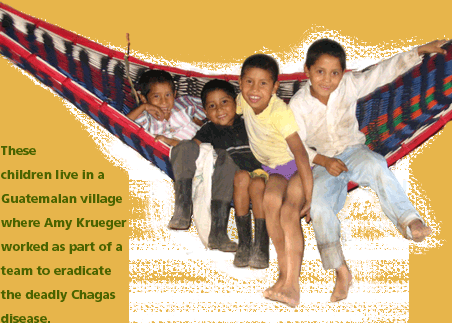












|
 |
| |
|
|
| |
Contaminated
water in tsunami-ravaged Indonesia, HIV in Africa, family planning
in India: MPH students learn vital lessons about public health in
the field. |
|
| |
|
|
| |
Stephanie
Maurissen was on the way to Bolivia to help clean up a
river contaminated by metal from a silver mining operation when
a coup overturned the government and politicized the decontamination
project. She had to make new plans—fast.
“Flexibility, flexibility, flexibility,”
says Deborah McFarland in listing the most essential quality in
doing international field study. “Nothing ever works the way
you think it will. You have to adapt.”
McFarland, associate professor in
the Hubert Department of Global Health, directs the Global Field
Experience (GFE) program, in which Maurissen participated this past
summer. “The field experiences are a testing ground for students,”
says McFarland. “Some get verification that they have found
their niche. Others come back and say this isn’t what they
want. These experiences also put students in the trajectory of their
role models. They help shape the next generation of public health
advocates, policy-makers, and researchers. That’s a legacy.” |
|
| |
|
|
| |
INSPIRATION
IN BURKINA FASO: SALLY HONEYCUTT |
|
| |
The
Scenarios from Africa project takes the best ideas from
African teens about how to prevent AIDS and puts them on film, directed
by internationally acclaimed artists. Originating in Senegal, Mali,
and Burkina Faso, the HIV/AIDS education project for young people
has now spread to 35 countries in Africa. Sally Honeycutt headed
to Burkina Faso this summer to evaluate the impact of the films.
In Titao she found inspiration. It
came in the person of Konfé Fatao, a local teacher and AIDS
activist. Titao is a remote village with no electricity, and Fatao
is able to show some of the 28 Scenarios films only when
he has gas for a generator. However, when there is no gas, he is
still using the content of the films to spark discussions about
AIDS with his students. He acts out scenes. He quotes dialogue.
He asks questions.
Through Fatao, Honeycutt visited villages
even more remote than Titao to hold focus groups with Africans between
the ages of 15 and 24 who had viewed the films. She wanted to find
out what the young people thought of what they’d seen. Which
scenarios seemed the most real to them? What situations existed
in their own communities that led them to confront AIDS? The most
common theme that emerged from this focus group and others Honeycutt
conducted was a prevalence of transactional sex, ranging from sex
between a girl and boyfriend who brought her gifts to sex between
a girl and an older man in exchange for a commodity such as a cell
phone.

Honeycutt also observed eight screenings
of Scenarios to see how partners were using the films.
She found a great variation in use, with a frequent discrepancy
between an ideal and actual use of the films. Whereas Fatao was
an inspiring presenter, other facilitators lacked training and support
to lead effective discussions.
Previously, Honeycutt had served in
the Peace Corps as a maternal child health educator in Gabon in
central Africa. The reason she returned to Africa—in fact,
the reason she enrolled in the MPH program at the RSPH—was
to get missing skills. While she was well versed in program management,
she wanted to add project evaluation and research skills to her
experience and hone her ability to apply theory. This field experience,
funded by an O.C. Hubert Fellowship in International Health, allowed
her to do just that. |
|
| |
|
|
| |
|
|
| |
LESSONS
FROM THE TSUNAMI: ASTRID SUANTIO |
|
| |
By
the end of the day in Aceh, Indonesia, Astrid Suantio would have
a sore throat. She was there to evaluate and monitor a point-of-use
water intervention in relief camps for displaced people in an area
hardest hit by the December 2004 tsunami, but her fluency in the
local language made her a frequently sought translator.
After the tsunami, these camps opened
with temporary housing consisting of 12-room barracks, with five
to 12 people per room. The high population density contributes to
an increased risk of outbreaks of infectious diseases. A lack of
clean drinking water makes diarrheal disease a particular concern
in the camps.

Suantio, supported by the Eugene J.
Gangarosa Scholarship Fund, was evaluating an intervention developed
by CDC scientists and provided by CARE International Indonesia called
the Safe Water System (SWS). The SWS consists of water disinfection
with chlorine, safe storage in narrow-mouthed containers to avoid
recontamination, and behavior change communication. During three
months in Aceh, Suantio took surveys throughout the Aceh province
to see how people were implementing the SWS in emergency conditions.
Working with colleagues, she went into homes to process water samples,
test for E. coli, and interview people about use of the SWS. She
gave workshops on the SWS for local nongovernmental organizations
and community leaders, and she helped CARE with a hand-washing project
for people living in the camps.
“The most valuable life lesson
I got in Aceh is that human beings are incredible,” says Suantio.
“They have the greatest capability to cope with pain and move
on with life. Even though I heard many stories about the tsunami
from the affected people themselves, not one person that I met still
dwelt on the sadness caused by the tsunami. Yes, they talked about
it and still mourned their loved ones, but they were also optimistic,
trying to rebuild Aceh and their communities as fast as they could,
believing the new Aceh would be better than before.” |
|
| |
|
|
| |
|
|
| |
| |
|
|
| |
On-the-job,
in-the-field training |
|
| |
|
|
| |
The
Global Field Experience (GFE) awards partially support
field research around the globe for 45 to 55 students each
year. While many students arrive on campus with previous international
experience, the GFE awards allow them to apply newly acquired
public health knowledge and skills to real-life health settings
and challenges worldwide. Working on a public health project
in the field gives students value-added, practical skills
that will enhance their future careers, says Deborah McFarland,
who directs the program.
These awards represent one of
the distinguishing hallmarks of the global health program
in the Rollins School of Public Health. “Clearly one
of the things that differentiates Emory is the global field
experience,” says McFarland.
|
|
| |
| |
Supported by three endowments—the
Eugene J. Gangarosa Scholarship Fund, the Anne E. and William
A. Foege Global Health Fund, and the O.C. Hubert Fellowships
in International Health—the GFE awards usually cover
airfare, Medevac insurance, and a portion of living expenses
to enable students to gain international field experience.
Often students procure additional support from sponsoring
organizations. And as a group, they raise funds through the
annual sale of a calendar featuring photos taken during the
previous field experiences. Last year this RSPH Student Initiative
Fund contributed $9,000 to the GFE program, sending eight
students abroad for research.
A recent commitment by the Hubert
Foundation will double its endowment for GFE awards, allowing
more students to participate. Maya Ravani applauds that move.
She evaluated a clean water campaign in Kenyan schools this
summer and is continuing to help the CARE-affiliated project
develop a water curriculum for teachers. “Without this
support, I wouldn’t have been able to go,” says
Ravani.
Not only does the global field
experience come with financial support, it also jump-starts
completion of the master’s thesis. The application process
is thorough, requiring potential participants to choose a
project and make the networking connections they will need.
Students are helped in that networking by a faculty with connections
worldwide. Finally, the field experience is the first step
in establishing a global health career, where experience abroad
is a prerequisite.
For more information on supporting
a global field experience, please contact Kathryn Graves,
assistant dean of development and external relations, 404-727-3352,
kgraves@emory.edu. |
|
| |
|
|
|
|
| |
|
|
| |
|
|
| |
PLANNING
FAMILIES IN INDIA: JENNIFER SCHARFF |
|
| |
When
Jennifer Scharff was working as a Peace Corps volunteer in Togo,
she saw four girls die of self-induced abortions. By contrast, this
past summer, she worked on reproductive health in India, where abortion
is legal.
For her global field experience, Scharff,
a Woodruff Scholar at the RSPH, chose to study women’s decision-
making power and perceptions of contraceptive methods in rural India.
Through surveys, focus groups, and interviews, she assembled a reproductive
health portrait of families in Pune in the Maharasta region, gathering
information about contraceptive knowledge and attitudes.
Working out of the Vadu Rural Health
Program, she found a fertility rate of 2.8 children per family.
Currently 80% to 90% of all contraceptive use in India is female
sterilization, reflecting Indira Ghandi’s push for it in the
1970s. The government also offers birth control pills, condoms,
and IUDs free of charge and supports a media campaign encouraging
families to limit children to two. A woman typically lives with
her husband’s family, although, as Scharff found, that trend
is starting to change in Pune as the economy is improving (particularly
when wives don’t get along with their mothers-in-law).
“I saw things changing right
before my eyes,” Scharff says. “The middle class is
small, but it is growing quickly.”

During her study, which was supported
by a Hubert Fellowship, Scharff discovered a lack of contraceptive
education by physicians. Some women lacked a knowledge of the side
effects of contraceptives. They blamed contraceptives for backache,
heart attacks, and loss of fertility. Some of the women were afraid
an IUD would go into their hearts. “The approach of doctors
to counseling about contraceptives is, ‘Don’t ask, don’t
tell,’” says Scharff. She also found that contraceptives
were not used for family planning to space children—something
that she would recommend.
Scharff plans to return to work in
both India and Africa, and she remains committed to reproductive
health in the developing world. That’s a big step for a Memphis
native whose parents never had passports until their daughter began
working overseas. |
|
| |
|
|
| |
|
|
| |
WATER
EFFORTS IN KENYA: MAYA RAVANI AND RACQUEL STEPHENSON
|
|
| |
The
Safe Water System was working so well on a small scale in Kenya
that CARE decided to dramatically ramp up the effort in schools
in the Nyanza province this year. With connections arranged through
the Emory Center for Global Safe Water, Maya Ravani headed over
this past summer to assist the organization in evaluating the effort.
She wanted to see if schoolchildren were effective promoters of
safe water handling and proper hand washing to their classmates
and families. But what she found was a project big on enthusiasm
by its partners but short on staff and resources—only one
field officer to implement the program at all 45 schools, only one
truck to transport the oversized storage containers for holding
disinfected water, schools located so far apart and on such rough
roads that only one or two could be visited in a day, and intermittent
outages of electricity.

Racquel Stephenson went to the same
locale as Ravani, but she worked with hospitals rather than schools
to evaluate implementation of the SWS. The program was launched
there in 2004, and she wanted to see whether the nurses’ teaching
practices and utilization rates had changed. She faced her own challenge
when a nursing suspension by the government in Siaya put the project
on hold, giving her no ongoing effort to evaluate.
Both students—supported by the
Gangarosa Fund—decided to change gears. Ravani worked with
baseline data previously collected and pitched in to help the field
officer implement the program. Stephenson decided to supplement
her one-year follow-up with a population survey to see how many
people had received information about the SWS and to determine the
sources of that information.
“I had a totally different idea
of what I’d do,” says Ravani, “but you can’t
really know what’s going on 7,000 miles away until you get
there.” She is continuing to help CARE Kenya in developing
an age-appropriate curriculum for the SWS that can be replicated
in other regions.
Stephenson returned from her first
overseas research experience confident that she has evaluation skills
that can be applied to future assignments. “The organizers
allowed this to be my project. They were stakeholders, but this
project became my baby,” she says. |
|
| |
|
|
| |
|
|
| |
FIELD
NOTES |
|
| |
| |
|
|
| |
|
|
| |
|
|
| |
MAPPING
CHAGAS DISEASE IN LATIN AMERICA: AMY KRUEGER |
|
| |
Amy
Krueger found her global field calling in Guatemala, working to
help eradicate a devastating parasitic disease.
This past summer with the support
of the Anne E. and William A. Foege Global Health Fund, Krueger
worked with the International Development Research Centre (IDRC)
and the Laboratory of Applied and Medical Entomology (LENAP) on
a project to prevent Chagas disease. Chagas is transmitted through
the triatomine parasite, which is found only in Latin America. The
disease produces flulike symptoms, and in its chronic form, it can
lead to lesions in the heart, esophagus, colon, and peripheral nervous
system. More than 100 million people, or 25% of the inhabitants
of Latin America, are at risk of being infected with the parasite,
and in Guatemala, 730,000 people are affected, with 30,000 new cases
each year.

LENAP and the IDRC are taking an ecological
approach to decrease infestation by the triatomine parasite. Researchers
at these organizations believe that changes to the ecosystem can
lessen the impact of the disease. The project on which Krueger worked
encourages the replanting of natural habitat for the wild animals
on which these parasites normally feed.
Krueger’s specific research
role was to record the latitude and longitude points on each house
in the two study villages of La Brea and El Tule. She took GPS coordinates
on approximately 300 homes, mapping each house and collecting information
on the types of vegetation. She also collected plant samples in
the Guatemala countryside to document dominant species. With this
information along with earlier collected data on socioeconomic status
and variables such as the presence of chicken coops, she is now
completing maps and a spatial analysis of the high risk factors
for contracting Chagas.
|
|
| |
|
|
| |
|
|
| |
PORTABLE
WATER FOR ECUADOR: STEPHANIE MAURISSEN |
|
| |
As an intern at CARE headquarters in Atlanta in the water sector,
Stephanie Maurissen read a lot of reports from the field that she
didn’t understand. They seemed too idealistic to be true.
But after a summer of studying the implementation of an actual water
system in Ecuador, she changed her mind.
Maurissen’s summer field experience,
supported by the Gangarosa Fund, gave her the context she needed.
She learned that two obstacles to implementing water systems in
Latin America are sustainability and ownership. In the past, agencies
have installed new potable water systems, only to find them broken
after a year or two with no back-up plan for maintenance and no
money for repairs. By failing to involve the local community in
the installation and maintenance of the system, agencies miss an
opportunity to give ownership to the people who will use the system.
CARE was trying to avoid those pitfalls.
The organization was building deep wells and installing pipelines
to bring water into homes as well as offering hygiene education.
It required the community members themselves to provide the manual
labor for the project—no small requirement considering the
work entailed in chiseling miles of beds for pipes into granite.
In turn, CARE not only provided the initial expertise for installing
the system but also trained a local operator who could fix it when
it broke down. CARE also instituted a tariff system from $0.80 to
$2.00 per month for water usage, the money being banked for future
repairs.
Maurissen evaluated the social services
component of the CARE study, finding that the implementation in
Ecuador was working well. She synthesized previous evaluation documents
into one comprehensive guide, developed a community questionnaire
to evaluate the project, and tested the evaluation tool in six communities:
three with potable water systems and three that are currently on
the waiting list for these systems. She found the time community
members saved in not having to carry water into their homes was
being funneled into a microenterprise set up by the community.
In the course of her research, Maurissen
also discovered a career calling to improve water systems. She’s
already begun by setting up a water alliance in Latin America.
|
|
| |
|
|
| |
|
|
|
|
|
|



